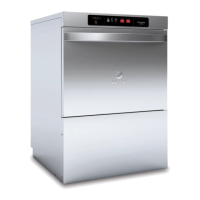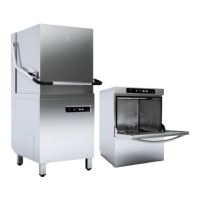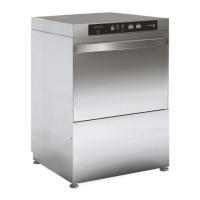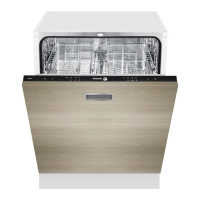5.2 Thermo-stop Function (MOD “B”, MOD “C”)
When the thermo-stop is activated, the wash cycle is extended, if necessary, until the boiler reaches a rinse
temperature which will guarantee correct hygienisation in accordance with health regulations.
If the water input temperature is lower than 40 ºC / 104 ⁰F, the times required to
reach the operating temperatures will increase and productivity levels will
decrease. The thermo-stop function may extend the wash cycle times.
In models fitted with this function, the wash cycle may be extended by up to a maximum of 8 minutes, at
which point the rinse cycle will start regardless of the rinse temperature.
Models "B" and "C" also have the EFFI-RINSE SYSTEM, which ensures a correct hygienisation
temperature at all times and a constant rinse pressure.
In MOD "C" machines, this function can be activated or deactivated using the User Menu. (Chapter
5.1.1)
To activate or deactivate this function in the other models, contact the technical service.
5.3 SOFT models with built-in descaler (MOD "C")
In the SOFT version machines, the dishwasher is fitted with an intake water descaler system.
If the water hardness is more than 45 ºfH / 31.5 ºeH / 25.2 ºdH, an external descaler must be installed.
The built-in descaler eliminates the water hardness resulting from excess calcium and magnesium, which
are the causes of scale on the appliance.
Before starting the appliance, fill the corresponding reservoir with regeneration salt for descalers (coarse
salt, max. grain size 5 – 7 mm, do not use tablets) and potable water (do not use common salt or any other
type of liquid).
To fill the regeneration salt reservoir, proceed as follows:
- Open the hood of the appliance.
- Remove the basket from the machine.
- Unscrew the salt reservoir cap located in the upper part of the tub.
- Using a funnel, pour regeneration salt into the reservoir. The first time, fill with 1 kg of regeneration
salt and top up the remaining space with potable water. On subsequent occasions, only add 0.5kg
of regeneration salt; the reservoir will have the required amount of water.
- Clean the seal and the edges of the reservoir carefully before replacing the cap in order to prevent
oxidisation.
- Replace the cap and tighten securely.
After analysing the hardness of the water, the technician should change the water hardness setting in
accordance with the measurements in the configuration menu.
